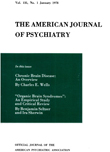INTELLECTUAL AND AFFECTIVE FUNCTIONS IN CHRONIC BRUCELLOSIS
Abstract
The Rorschach test was administered to 3 diagnostic groups composed of patients with neurosis, organic brain damage, and brucellosis. The subjects were individually matched in the 3 groups on the basis of sex, age, formal education, and IQ. Intergroup statistical comparisons were made of the mean performances on each of the Rorschach variables. Secondly, the frequency with which scores in one group exceeded the matched scores in the other groups was tabulated and the frequency differences tested for statistical significance. The relative frequencies of Rorschach "signs" of organic cerebral damage in the 3 groups were also compared statistically. The results obtained indicate quite consistently that the scores of subjects with brucellosis fall between those of the other 2 groups. Generally, the brucellosis group is more similar to the neurosis group with respect to Rorschach variables having primarily intellectual significance, and more similar to the brain-damaged group with respect to reduction of emotional spontaneity and capacity for emotional responsiveness. The various Rorschach "signs" of brain damage occur much more frequently in brucellosis than neurosis (p..001). While these signs occur more frequently among brain-damaged patients than those with brucellosis, the statistical significance is not as great (p..05). An interpretative review of the protocols in the 3 groups indicates a considerable amount of neurotic symptomatology in each group, but confirms the earlier result of typical indications of organic brain involvement occurring among the patients with brucellosis as well as those with verified brain damage.
Access content
To read the fulltext, please use one of the options below to sign in or purchase access.- Personal login
- Institutional Login
- Sign in via OpenAthens
- Register for access
-
Please login/register if you wish to pair your device and check access availability.
Not a subscriber?
PsychiatryOnline subscription options offer access to the DSM-5 library, books, journals, CME, and patient resources. This all-in-one virtual library provides psychiatrists and mental health professionals with key resources for diagnosis, treatment, research, and professional development.
Need more help? PsychiatryOnline Customer Service may be reached by emailing [email protected] or by calling 800-368-5777 (in the U.S.) or 703-907-7322 (outside the U.S.).



